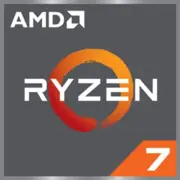AMD Ryzen 7 4700G (OEM Only)

AMD Ryzen 7 4700G (OEM Only): Compact Power for Versatile Tasks
Relevant as of April 2025
Key Specifications: Architecture and Main Features
The AMD Ryzen 7 4700G is an 8-core APU (Accelerated Processing Unit) built on the Zen 2 architecture, released in 2020 but still relevant for budget and compact systems in 2025. It combines a CPU and integrated Radeon graphics, making it an ideal solution for PCs without a discrete graphics card.
Fabrication Process and Energy Efficiency
- 7nm TSMC FinFET Technology: Ensures low thermal output (TDP of 65 W) and high performance per watt.
- 8 cores/16 threads: Base frequency of 3.6 GHz and maximum of 4.4 GHz.
- Integrated Graphics: Radeon Vega with 8 compute units (512 stream processors), frequency up to 2100 MHz.
Cache and Performance
- L3 cache of 8 MB (less than the Ryzen 7 5700G, which has 16 MB).
- In Cinebench R23 tests: ~12,500 points in multi-threaded mode.
- The graphics can handle games at low settings: for example, Fortnite at 1080p/30 FPS or CS2 at 720p/60 FPS.
Key Features
- Supports PCIe 3.0 (not 4.0 like the Ryzen 5000 series).
- AMD Precision Boost 2 and StoreMI technologies for performance optimization.
Compatible Motherboards: Sockets and Chipsets
The Ryzen 7 4700G uses the AM4 socket, allowing for a wide range of motherboard options, but with certain considerations.
Recommended Chipsets
- B550: The optimal choice. Supports PCIe 4.0 for NVMe drives (though the processor itself operates on PCIe 3.0). Examples of motherboards: ASUS TUF B550-PLUS ($120–$150).
- X570: An overkill option, suitable for upgrades. For example, MSI MPG X570 GAMING EDGE WIFI ($180–$200).
- A520: Budget boards with no overclocking, suitable for office builds (Gigabyte A520M S2H, ~$70).
Selection Considerations
- BIOS updates: Some boards may require updates for compatibility with Ryzen 4000G.
- Built-in Wi-Fi and HDMI 2.0 are useful for mini-PC setups.
Supported Memory: DDR4 and Tuning Tips
The processor works only with DDR4, which in 2025 appears limited against the widespread transition to DDR5.
RAM Recommendations
- Frequency: up to 3200 MHz (official support). Overclocking to 3600 MHz is possible, but stability depends on the motherboard.
- Dual-channel mode: essential for unlocking the potential of integrated graphics. Example: 2×8 GB DDR4-3200 (TeamGroup Vulcan Z, $50 for the kit).
- Timings: CL16 or lower will improve responsiveness in games.
Power Supplies: Power Calculation
With a TDP of 65 W, the Ryzen 7 4700G does not require a powerful PSU, but the choice depends on upgrades:
- Without a discrete graphics card: A PSU of 300–400 W is sufficient (Be Quiet! Pure Power 11 400W, $60).
- With a graphics card like NVIDIA RTX 4060: A PSU of 550–650 W (Corsair CX650M, $80).
- Tip: Choose power supplies with an 80+ Bronze certification or higher for reliability.
Pros and Cons: Who Should Take Notice
Advantages
- Powerful integration of CPU + GPU: suitable for compact PCs.
- Low power consumption: ideal for media centers or offices.
- 8 cores: multitasking in rendering or streaming.
Disadvantages
- OEM status: hard to purchase separately (price in systems — $200–250).
- Lacks PCIe 4.0 and DDR5: falls behind newer APUs like the Ryzen 5 8600G.
- Underwhelming for modern AAA games: a discrete graphics card is recommended.
Usage Scenarios: Gaming, Work, Multimedia
1. Office Tasks and Multitasking
- Running dozens of tabs, working with Excel, and graphic editing software.
2. Media Center
- 4K video via HDMI 2.0, streaming Netflix.
3. Light Gaming
- Games like Dota 2, Rocket League, or indie titles.
4. Entry-Level Workstation
- Rendering in Blender, compiling code.
Comparison with Competitors
- AMD Ryzen 5 8600G (2024): 6 cores Zen 4, RDNA 3 graphics, DDR5. 30% faster in games but more expensive ($300).
- Intel Core i5-13400: 10 cores (6P + 4E), UHD 730. Better in single-threaded tasks but weaker in multi-threading.
- Ryzen 7 5700G: 8 cores Zen 3, Vega 8. 15% faster CPU and GPU, but hard to find as new in 2025.
Practical Build Tips
1. Cooling
- The stock cooler will suffice, but for quiet operation, consider the DeepCool GAMMAXX 400 V2 ($25).
2. Case
- Mini-ITX for compactness (Cooler Master MasterBox NR200, $80).
3. Storage
- NVMe SSD (WD Blue SN580 1TB, $70) for fast boot times.
4. BIOS Optimization
- Enable XMP for RAM and configure power-saving settings.
Final Conclusion: Who is the Ryzen 7 4700G Suitable For?
This processor is a good choice if:
- You need a budget-friendly PC without a discrete graphics card.
- Silence and compactness are valued (for instance, for office or HTPC use).
- You need multi-threaded performance within a budget.
In 2025, the Ryzen 7 4700G remains a niche solution, but it can be found in ready-made OEM systems or refurbished PCs. For gaming or professional tasks, it’s better to consider newer APUs or hybrid builds with discrete graphics.
Basic
CPU Specifications
Memory Specifications
GPU Specifications
Miscellaneous
Share in social media
Or Link To Us
<a href="https://cputronic.com/index.php/cpu/amd-ryzen-7-4700g-oem-only" target="_blank">AMD Ryzen 7 4700G (OEM Only)</a>